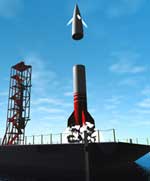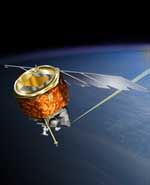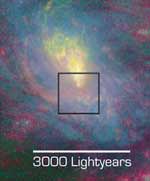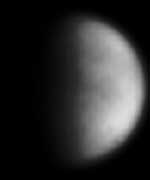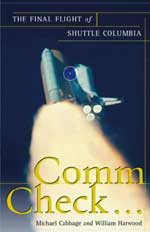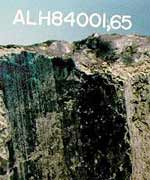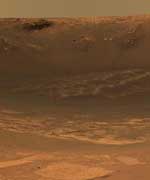
Image credit: NASA/JPL
Scientists and engineers celebrated when they saw the first pictures NASA’s Opportunity sent from the rim of a stadium- sized crater that the rover reached after a six-week trek across martian flatlands.
Multiple layers of exposed bedrock line much of the inner slope of the impact crater informally called “Endurance.” Such layers and their thicknesses may reveal what the environment on Mars was like before the salty standing body of water evaporated to produce the telltale rocks that were explored in the tiny “Eagle” Crater. That?s where Opportunity spent its first eight weeks on Mars.
“It’s the most spectacular view we’ve seen of the martian surface, for the scientific value of it but also for the sheer beauty of it,” Dr. Steve Squyres of Cornell University, Ithaca, N.Y., said about a color panorama of Endurance Crater released at a news conference today at NASA’s Jet Propulsion Laboratory, Pasadena, Calif. He is the principal investigator for the science instruments on both Opportunity and its twin Mars Exploration Rover, Spirit.
In coming days, Opportunity will circle the rim of Endurance, observing the crater’s interior from various angles. Scientists and engineers have begun to identify interesting science targets and assess how difficult it would be for the rover to descend partway into the crater and climb back out. “We will need to decide whether the science is compelling enough to send the rover into a crater it might never leave, or whether to explore other sites first before entering Endurance,” said Orlando Figueroa, director of the Mars Exploration Program, NASA Headquarters, Washington.
At Eagle Crater, an outcrop of bedrock only about the height of a street curb yielded evidence that the site was once covered by a body of salty water deep enough to splash in. “That was the last dying gasp of a body of water,” Squyres said. “The question that has intrigued us since we left Eagle Crater is what preceded that. Was there a deep body of water for a long time? Was there a shallow, short-lived playa? We don’t know.”
The strategy for seeking answers is to examine older rocks from deeper layers, so Opportunity was sent on drives totaling about 800 meters (half a mile) to reach the deepest crater nearby, Endurance. This crater excavated by the impact of a tiny asteroid or a piece of a comet is about 130 meters (430 feet) wide and, from the highest point on the rim, more than 20 meters (66 feet) deep, 10 times as deep as Eagle. An exposure of outcrop in a cliff high on the inner wall across from the rover’s current position reveals a stack of layers 5 to 10 meters (16 to 33 feet) tall. Other exposures around the inner slope of the crater may be more accessible than the cliff, and chunks from the same layers may have been thrown out onto surrounding ground by the crater-forming impact.
“There is a rock unit below what we saw at Eagle Crater,” Squyres said. “It looks fundamentally different from anything we’ve seen before. It’s big. It’s massive. It has a story to tell us.”
Brian Cooper, leader of JPL’s squad of rover drivers for Spirit and Opportunity, said the initial view of the crater doesn’t settle accessibility questions yet. “The slope right in front of us averages 18 to 20 degrees. Getting into the crater is no problem, but we have a lot more work to do to assess whether we could get back out. That depends on soil properties and slippage, as well as slope.” The planned circuit around the rim will also require careful navigation. “If you don’t go close enough to the lip, you can’t look in, but if you go too far, you could fall in,” he said. “We’re going to have a very interesting few weeks.”
When NASA sent astronauts to the lunar surface more than 30 years ago, it was decided not to allow them to enter craters as fresh and steep as Endurance, but Opportunity may be able to do what no human has done before on another planet.
Scientists and engineers working with the other rover, Spirit, are also examining images of a destination area to identify possible targets of study and to assess how well the rover can get to them. However, that destination area, informally named “Columbia Hills,” still lies several weeks of travel ahead of Spirit. Images and surface-temperature information from the NASA orbiters Mars Global Surveyor and Mars Odyssey are supplementing Spirit’s own increasingly detailed pictures of the hills. Nighttime surface temperatures indicate that some areas within the hills are rockier than others, said Amy Knudson, a rover science team collaborator from Arizona State University, Tempe.
“The hills represent a different rock unit, likely older than the plains we’re on,” Knudson said. “There are intriguing features in the hills and we want to investigate the processes that formed them. We’re especially interested to see if water played any role.”
JPL, a division of the California Institute of Technology in Pasadena, manages the Mars Exploration Rover project for NASA’s Office of Space Science, Washington, D.C. Images and additional information about the project are available from JPL at http://marsrovers.jpl.nasa.gov and from Cornell University at http://athena.cornell.edu.
Original Source: NASA/JPL News Release

